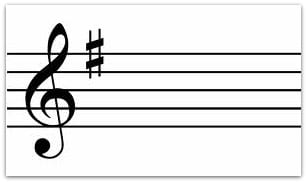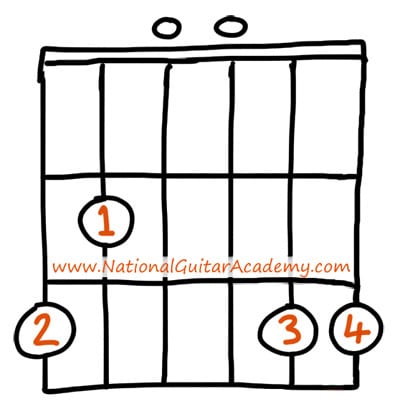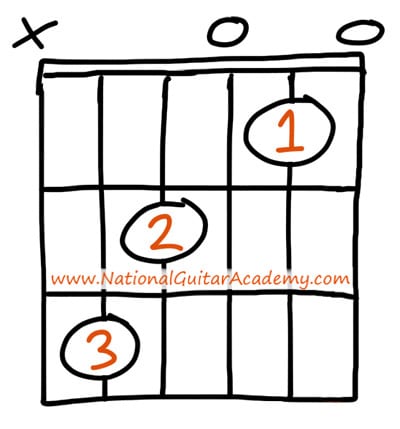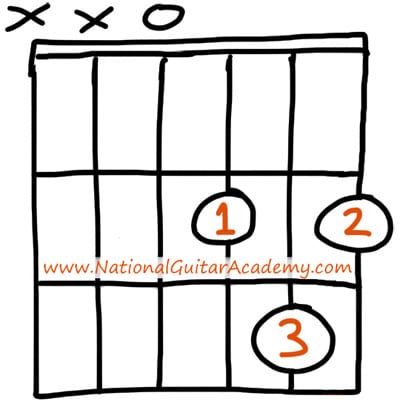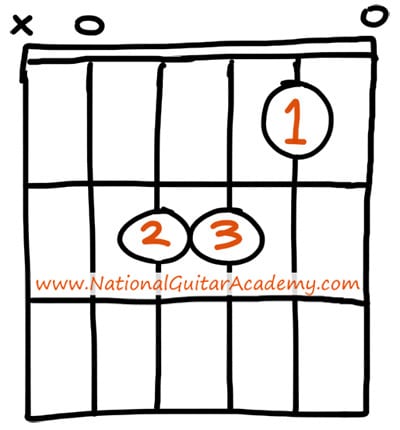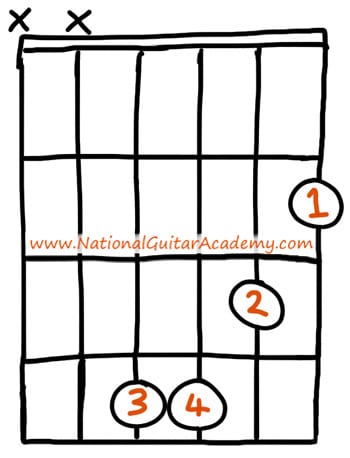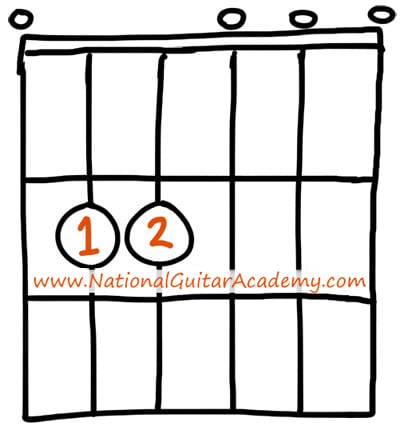The chords in the key of G are probably the most common guitar chords of all. This is a fundamental group of chords for all guitarists to know. So let’s dive in!
In this free guitar lesson you will learn:
- how to find chords in the key of G major
- how to play the most useful chords in the key of G major
- 10 simple songs using chords in the key of G major
Over 250,000 guitar-learners get our world-class guitar tips & tutorials sent straight to their inbox: Click here to join them
The chords in the key of G are:
G, C, D, Em, Am, Bm, F# diminished
Why is knowing the chords in the key of G so useful?
It is useful to know how chords go together in a specific key for 6 important reasons:
- it can help you work out elusive chord progressions in your favourite songs;
- it can help you develop and strengthen your composition and songwriting skills by creating moods;
- it can take your jam sessions into new and more interesting places;
- it can make your accompaniments to singers more varied;
- it can help you play along with different instruments that have fixed tuning;
- it can enrich your improvisation skills and lead guitar work.
Now let’s discuss keys and why they matter…
(Then we’ll look at each chord in the key of G and discuss it in more detail.)
What is a key?
As the word suggests, a key is a sequence of notes that will help you slot into and unlock the secrets of a piece of music that otherwise, on first listening, seem tricky to work out.
There are many different keys, but all of them are made up of a set pattern of notes that correspond to a musical scale.
What is a scale?
A musical scale is set of notes that follows a defined pattern of sounds.
The commonest scale in western music is a major scale and it follows the tune of doh-rey-me-fah-soh-lah-tee-doh, made popular in the song from ‘The Sound of Music.’
The 7 notes of the major scale always follow a pattern of 7 intervals:
2-2-1-2-2-2-1
For example, the scale of G major is:
G A B C D E F#
You will notice that there is only 1 sharp note.
In stave notation, you can spot when a song is in the key of G major by looking for this:
Learn 12 EASY beginner chords with our popular guide

✅ Stop struggling. Start making music.
✅ Learn beginner-friendly versions of every chord.
This is our most popular guide and it will improve your chord ability quickly! 😎
Get your own personalised guitar-learning plan 🎸
Get a custom guitar-learning plan here: Click here for GuitarMetrics™
World-Class Guitar Courses 🌎
Learn from the world's best guitar educators: Click here for our guitar courses
How does this help you with the chords in the key of G major?
The chords in a major key always correspond to the major scale pattern, so logically, the chords in the key of G major follow the same pattern as the scale of G major.
However, there are 2 important points to remember:
First, for a chord to be consider as part of the key family, it must be made up from the notes of its parent scale. Therefore all the chords in the key of G major must be created from combinations of the seven notes:
G A B C D E F#
This means that although the scale might have A in it this does not mean the chord of A will be, since an A chord contains C# which is not in the scale of G major.
Second, to make it simple, the chords in a major key must stick to this pattern:
MAJOR, MINOR, MINOR, MAJOR, MAJOR, MINOR, DIMINISHED
Sometimes Roman numerals are used to help identify these. Major chords are capitalised and minor and diminished chords are lower case:
I, ii, iii, IV, V, vi, vii
So, what are the chords in the key of G major?
Well following the pattern outlined above, the chords in the key of G major must be:
G, Am, Bm, C, D, Em, F#dim
Now you know the notes to play, you can play the chords of G major all day!
Brilliant! Now let’s look at those chords in more detail.
The three most commonly used chords in the key of G major are:
G C D
These three chords lie at the heart of most tunes in G major from folk or blues to grunge and death metal.
Here are some examples of G C D chord songs:
- Chuck Berry’s ‘No Particular Place To Go,’
- Led Zeppelin’s ‘Hot Dog,’
- Queen’s ’39’ or
- Van Morrison’s ‘Brown-Eyed Girl.’
They can also form the basis for your own songwriting adventure.
The chord of G
The chord of G is based on the first note or root note of the G major scale.
G is a very versatile chord with a bright uplifting sound and because it can be played in a variety of positions it is suitable for all levels of guitarist.
The basic chord of G is made from three notes:
G B D – that is the first, third and fifth notes of the G major scale.
How these notes are fretted across the 6 strings of your guitar creates the different variations possible. The great news is that each variation has a slightly different effect.
In theory, you can create all sorts of G chords, however you might find you will need extra long fingers to be able to stretch to every option.
For example, D B G D G B would be challenging, whereas G B D G D G is quite easy.
Let’s look at the easiest option (the numbers in the chord box indicate the preferred positioning of each finger):
G Major
The chord of C
The chord of C has a happy voice and is based around the fourth note of the G major scale.
It appears in many tunes as it belongs to a natural set of chords that give a simple sound. The neat trick about a C chord is it can be played with 1 or 4 fingers depending on your level of ability.
The basic chord of C should include the three notes:
C E G – these are the fourth, sixth and first notes of the G major scale.
Let’s look at the easiest option (the numbers in the chord box indicate the preferred positioning of each finger):
C Major
The chord of D
The chord of D has a bright voice and quite ‘poppy’.
It is based around the fifth note of the G major scale. The chord of D requires at least 2 fingers, but has enough variations to satisfy most players of all levels.
The basic D chord should include:
D F# A – these are the fifth, seventh and second notes of the G major scale.
Let’s look at the easiest option (the numbers in the chord box indicate the preferred positioning of each finger):
D Major
Download our lead guitar cheat-sheet to make things easier
It's hard to understand which scales work with which keys.
So we created a cheat-sheet! A key and scale-finder that you can use again and again.

Get your personalised guitar-learning plan 🎸
Get a custom guitar-learning plan here: Click here for GuitarMetrics™
World-Class Guitar Courses 🌎
Learn from the world's best guitar educators: Click here for our guitar courses
The chord of Am
The second chord in the key of G major is A minor.
It is based on the second note of the G major scale. This chord is great for creating sad moments in an otherwise straightforward song. It is a go to chord in any repertoire and can be played in a range of fret locations.
The basic chord of Am is made from three notes:
A C E – these are the second, fourth and sixth notes of the G major scale.
Let’s look at the easiest option (the numbers in the chord box indicate the preferred positioning of each finger):
A minor
The chord of Bm
The third chord in the key of G major is B minor.
This chord works well if a melancholy feel is required. It is a trickier chord to use as its harmonics can be at odds with a guitar’s standard tuning, so it needs careful fretting.
The chord of Bm is made up from three notes:
B D F# – these are the third, fifth and seventh notes of the G major scale.
Let’s look at the easiest option (the numbers in the chord box indicate the preferred positioning of each finger):
B minor
The chord of Em
The sixth chord in the key of G major is E minor.
This chord is very important because it is the relative minor chord of G.
- It is great for changing the overall positive mood of verses or choruses, created in the key of G major, into a gloomier, bass boom feeling of a bridge or middle eight.
- It can be played in a host of positions on the fret-board regardless of your ability.
The chord of Em is made up from three notes:
E G B – these are the sixth, first and third notes of the G major scale.
Let’s look at the easiest option (the numbers in the chord box indicate the preferred positioning of each finger):
E minor
The chord of F#diminished
The seventh chord in the key of G major is F#dim.
- This is an edgy chord that adds an element of mystery to tunes, almost like a musical question mark or to keep the listener guessing about what will happen next. As such it has to be treated with caution and not overused.
- Like Bm, it needs to be fretted carefully to avoid sounding discordant in standard tuning.
The chord of F#dim is made up from three notes:
F# A C – these are the seventh, second and fourth notes of the G major scale.
As you may notice it resembles the chord D7 (this can be used as a substitute).
Let’s look at the easiest option (the numbers in the chord box indicate the preferred positioning of each finger):
F#diminished
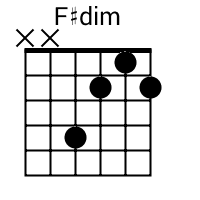
Bonus knowledge!
Now you know the main chords in the key of G, as a bonus you will also have automatically learnt all the main chords in the key of Em, because Em is G major’s relative key!
Therefore, the chords in the key of E minor are:
Em F#dim G Am Bm C D
Because the emphasis is on the minor chord, this key can be considered to be G major’s more plaintive twin sister.
What can I do next with all these chords in the key of G major?
Now you know the 7 main chords in the key of G major, you can:
- play loads of new songs
- compose some amazing tunes
- jam along or improvise like a guitar legend
10 Songs that use chords in the key of G major
Hundreds of songs use the chords in the key of G major and they cross all musical genres, including classical guitar.
Here are 10 to whet your appetite. They are, believe it or not, simply based around the chords of G C D with a few extra chords from the key thrown in.
- Wish You Were Here – Pink Floyd (C D Am G Em)
- Come As You Are – Nirvana (Em G D)
- Blackbird – The Beatles (G Am C D Em)
- Sweet Home Alabama – Lynyrd Skynyrd (D C G)
- Nothing Else Matters – Metallica (Em D C G Bm)
- Good Riddance – Green Day (G C D Em)
- Lyin’ Eyes – The Eagles (G C Am D)
- Ring of Fire – Johnny Cash (G C D)
- Sweet Child of Mine – Guns ‘n’ Roses (D C G)
- Banana Pancakes – Jack Johnson (C G D Am)
Some songs written using the chords in the key of G will drop in an occasional sharp chord so don’t be surprised if an A chord or B chord pop up from time to time, as these often give songs a bluesy twist.
Composing using chords in the key of G major
Your knowledge of the chords in the key of G major can help you to compose a range of tunes that capture very different moods or ideas.
Play any chord from the key of G with any other chord from the key of G and it will sound good!
For blues songs or pop songs with a 1950’s feel, use the chords G C D as your starting point use a 12 bar blues sequence.
For a soulful sound add a minor chord to create the pattern – G Am C D – ‘Stand by Me’ is a good song to listen to.
For added boom use Em as an ending to a chord sequence – G D/F# Em.
Add some suspense at the end of a chorus by using F#dim, before going back to a verse or into a bridge.
Simply running through the 7 basic chords will start to suggest songs. For example, The Beatles’ ‘Here There and Everwhere’ follows this pattern.
6 great ways to jam along to songs in the key of G major
Now you know some songs that use chords in the key of G major and E minor, you can jam along using your knowledge of scales, too.
For example, if you have a friend who plays the chords to ‘Let Her Go’ by Passenger, you can improvise using the scales of:
- G major,
- G major pentatonic,
- E minor and
- E minor pentatonic.
Or, if you want a bluesier sound why not try using:
- G minor and
- G minor pentatonic.
What Type of Guitarist Are You?
Take our 60-second quiz & get your results: Take The Quiz
Join the world's best online guitar school 🌎
- Get your own personalised guitar learning plan (customised just for YOU).
- World-class online guitar courses. Learn at your own pace.
- Community Campus & Learning Forum - A friendly community! Connect with our team & students. 😊
- Beginner Song library with chordsheets, tabs and tips. (Songs suitable for all levels!)
- Regular live streams, seminars and Q&A sessions - Learn from world-class guitar educators. Get all your questions answered!
Click here to learn more about National Guitar Academy membership 
Cool Guitar T-shirts 😎
Look cooler! Check out our merch: Click here to see our merch store
Want free guitar tips and video lessons delivered to your inbox?
Join over 250,000 other guitar learners and subscribe to our guitar-tips-by-email service. (It's free.)
We'll send you a series of lessons that will move you to the next level of your guitar journey.
Learn how everything fits together quickly, easily and effectively. We share ninja tips (for instant fun!) but also timeless fundamentals that will deepen your understanding.

Popular Lessons
How To Learn Guitar: An 11-Step Programme For Beginners
How To Choose The Perfect Beginner Guitar
More Cool Guitar Stuff
Learn about National Guitar Academy: About Us
Visit our YouTube channel for fun guitar videos.
Join us on Facebook for daily guitar tips.
Listen to our Learn Guitar Podcast for rapid guitar progress.
Check out our free chord lessons.
Get our best guitar tips & videos
Where should we send it?
Where should we send it?
Get our best guitar tips & videos

